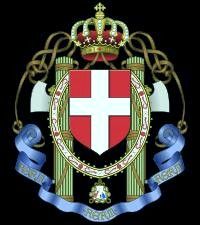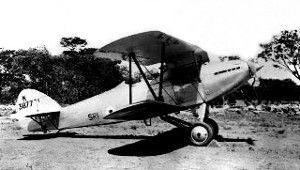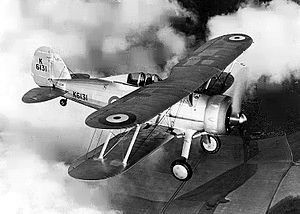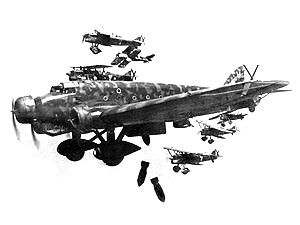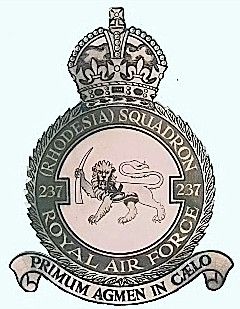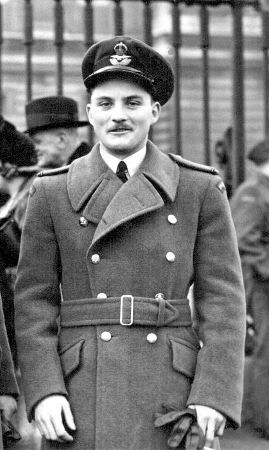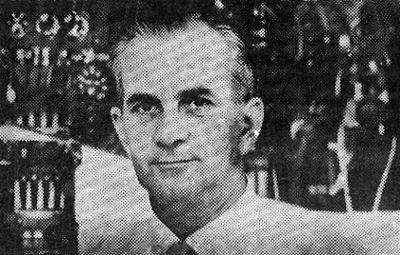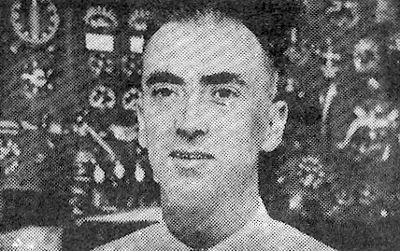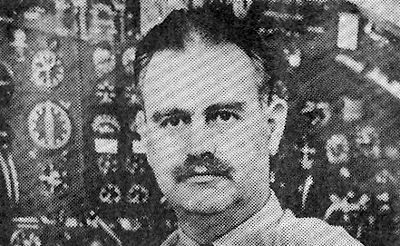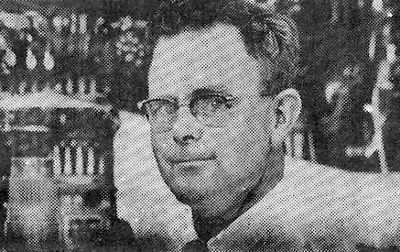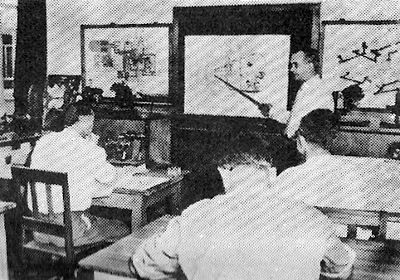Born – Salisbury, Southern Rhodesia 6/12/1921
Member of the Territorial Force, attested into the Southern Rhodesian Air Force (SRAF) 17/6/1940 and attested into the Royal Air Force Volunteer Reserve (RAF VR) 16/8/1940. Under went pilot training in Southern Rhodesia. Completed Operational Conversion Unit (OUT) with 16 OCU in the UK and then he was posted to 106 Squadron in October 1941. After completing his first tour of operation on the 28/8/1942, posted to 1654 Operational Conversion Unit, A Flight 44 (Rhodesia) Squadron. 13/12/1942 posted back to 106 Squadron.
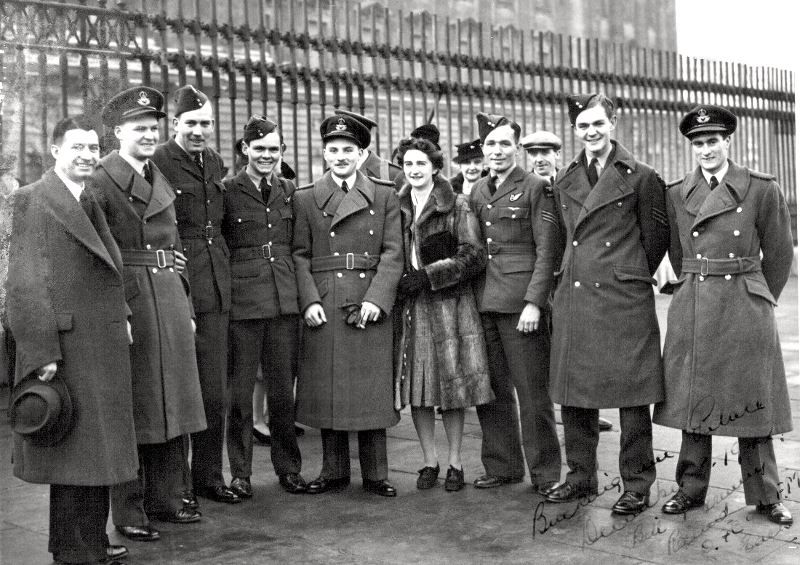
Awarded Distinguished Flying Medal (DFM) 12/3/1942, Commissioned 29/3/1942. Awarded Distinguished Flying Medal (DFC) 6/8/1942. Promoted to Flying Officer 1/10/1942. Killed on operations (shot down returning over northern France) 21/22/12/1942. The Lancaster R5574, Grimwood was the pilot and captain of the aircraft. They were shot down by a German night-fighter on returning from a raid on Munich. The Navigator Pilot Officer P C Moore was the only survivor. Philip Moore became Sir Philip Moore, Personal Secretary to Her Majesty Queen Elizabeth II. He was made a Peer in June 1985 when he retired after 20 years from his post of Personal Secretary.
Grimwood and 5 members of his crew are buried in the Church Yard at Beauforte-en-Argonne near Stenay in (Meuse) northern France.
He turned 21 on the 6/12/1942 and went to Buckingham Palace on the 8/12/1942 to receive his two decorations. He was killed on the 21/22/12/1942.
Granty (Florence - (formerly Cooke) Laland – Grimwood’s mother) corresponded with all the next of kin of Grimwood’s crew who were :-
80346 and 778834 Flight Lieutenant Grimwood Cooke DFC, DFM – Captain and pilot. (the first number is his Officer number and the second one is his NCO - Non Commissioned number)
938106 Sergeant F Morrell – Flight Engineer
1199335 Pilot Officer P C Moore – Navigator – taken POW (Prisoner of War) survived
922010 Sergeant A M Camplin – Air Bomber
623360 Flight Sergeant B G Lough DFM – Wireless Operator – has no known grave – he is listed on the Runnymede Memorial UK
120850 Pilot Officer B G Goodwin DFM – Gunner
658695 Sergeant M Reynolds - Gunner
Grimwood’s crew was the third most highly decorated crew to be lost on Operations – 1 DFC and 3 DFM’s
Grimwood also flew Hamdens
All Rhodesian airmen who joined the RAF VR wore a “Rhodesia” Flash on their left shoulder of which they were justly proud. They were sadly the only Commonwealth country to lose their identity beening absorbed into the RAF VR.
Gimwood’s DFM Citation reads:-
HIS MAJESTY has been pleased to approve of the award of the DISTINGUISHED FLYING MEDAL to Sergeant GRIMWOOD COOKE, No 106 Squadron, RAF Volunteer Reserve. This airman has participated in operational flying since September, 1941. He has captained his aircraft with a high degree of success when operating against targets as Essen, Cologne, Bremen, Kiel, Brest. His determination is such that after bombing he has frequently descended to low levels in order to machine-gun searchlight positions, gun posts and aerodromes. He bombed Kiel from 7,000 feet in the face of fierce opposition and on another occasion attacked Huls from only 4,000 feet. One night in November, 1941 he successfully placed a mine in a Norwegian fjord, then bombed docks at Oslo from 300 feet and machine-gunned an aerodrome nearby. He took part in two daylight raids over North-Western Germany, during which he displayed great skill and courage in accomplishing low-level bombing and machine-gun attacks.
Throughout this airman has displayed out-standing zeal and initiative.
The Secretary of State, London
Grimwood’s DFC citation reads:-
THE DISTINGUISHED FLYING CROSS has been awarded to Pilot Officer GRIMWOOD COOKE. As a pilot he is outstanding. Apart from routine raids he has to his credit many outstanding feats of courage, skill and endurance. During raids on Lubeck and Rostock he performed valiant work.
The Secretary of State, London.
NOTE
Grimwood – was the First Rhodesian on Bomber Command to be awarded a DFM
He was the First Rhodesian to receive both the DFC and DFM. There were only three Rhodesian’s to be awarded both the DFC and DFM.
He was the first and only member of 106 Squadron to receive both awards on a first tour of operations (30 missions).
Taken from “A Pride of Eagles” by Beryl Salt.
A report in the Rhodesia Herald 11th September 1942.
Pilot Officer Grimwood Cooke DFC, DFM, one of the best known Rhodesian bomber pilots, told guests at Rhodesia House in London, the other day, that he had never regretted choosing bomber-flying, if only because of the comradeship among the crews. His navigator is a New Zealander, his wireless operator a Scot and his gunner a Canadian.
“A bomber gives a wonderful panoramic view of interesting country,” he said., “and an opportunity to study and see the whole drama of the operations. Take that attack on the Renault works in Paris. To time the attack correctly, we toured Paris for half an hour. There was a bright moon and the whole city was lit up with flares from the early arrivals. Flak, searchlights were almost negligible.”
“While watching the earlier squadrons do their stuff I saw the Arc de Triomphe, the Eiffel Tower and the famous boulevards. When our turn came, we easily found the target, but the air was so full of our own machines we had to keep a careful watch to avoid collision. After dropping medium bombs, we circled for some time to watch the heavy bombs dropped by the later arrivals. As we left the scene my wireless operator said ‘Gosh! What a lovely sight!’ so we turned for another look. Finally, setting a course home, he started singing ‘The Last Time I saw Paris’. We all joined in.”
“My worst experience was on my fourth raid over Kiel. It was a stormy night with some mist and no horizon. I came down to 11,000 feet but as I still could not see much I went to 9,000 and then saw another aircraft in the searchlights. We went in but half the searchlights turned on us and we flew blind throwing the aircraft about to avoid the flak. My instruments toppled and I asked the navigator, ‘Are we upside down?’ He replied ‘By gosh we are! The stars are below us!’ I dived to 1,500 feet, righting the machine and climbed up again to 8,000 feet but again the searchlights got us. Fortunately, there was cloud just near the target area. We circled it and then made our own attack, dropped our bombs, climbed above the clouds and made for home.”
Prior to the war Grimwood was a clerk in the Public Works Department in Salisbury. Grimwood was educated at Chaplin School - Gwelo and Prince Edward School – Salisbury, S Rhodesia. He won a cup for boxing at school. Grimwood and Harold were at school with Ian Douglas Smith at Chaplin. Ian was later to become the Prime Minister of Rhodesia.
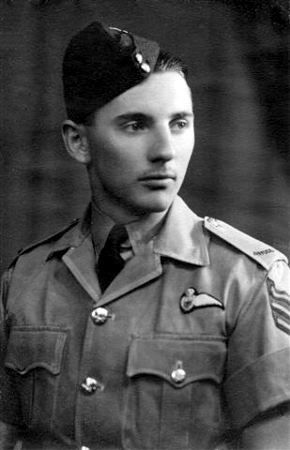 Harold Cooke
Harold Cooke
Harold Cooke
Twin brother of Grimwood
Born - Salisbury, Southern Rhodesia 6/12/1921.
Member of the Territorial Force, attested SRAF 18/11/1940, attested RAF VR 1/1/1941. Trained in Southern Rhodesia as an Air Gunner and posted to number 10 OUT (Operational Training Unit) at Morten-in-Marsh 24/3/1942.
He was killed on the Third Thousand Bomber Raid 25/6/1942 on Bremen whilst still under training.
He was a member of the crew (Rear Gunner) of Whitley AD 689 which crashed near Lingen, Germany – where the crew were all buried initially. Later re-interred and buried in the Reichswald Forest War Cemetery, near Kleeve, Germany. The cemetery is 4 kms from the German/Dutch border. It lies 5 km South West of Kleeve and 10 km from Gennep in Holland.
Harold’s crew were:-
R56284 Sergeant N M Oulster - Royal Canadian Air Force (RCAF)
1305420 Sergeant S J Webster – Air Bomber
1027321 Sergeant G A Hunt – Air Gunner
1381419 Sergeant D I Parry – Wireless Operator
Rhodesian 778541 Sergeant Harold Cooke – Air Gunner
Harold was an Assayer and Sampler on the Fred Mine, Filabusi, Southern Rhodesia before the war. His interests were all sports, shooting fishing and mechanics.
Harold was educated at Chaplin School and Prince Edward.
Grimwood’s medals
778293/80346 Flight Lieutenant Grimwood Cooke
DFM, DFC, 1939/45 Star, Air Crew Europe Star, Defence Medal, War Medal – all named.
Harold’s medals
778541 Sergeant Harold Cooke 1939/45 Star, Defence Medal, War Medal – all named
After the war Pilot Officer Philip C Moore had a very distinguished life. He played rugby for England. He was Governor of Sir Lanka.
Sir Philip Moore became Personal Secretary to Her Majesty Queen Elizabeth II.. He was a made a Peer in June 1985 when he retired from his post as Personal Secretary after 20 years.
Lord Philip Moore lived at Hampton Court in a “Grace and Favour” apartment when he retired with his wife Joanna. Peter, son, Grimwood, Pauline (his wife) and Anne visited them in 1994 and spent a delightful and very happy few hours with them. Philip gave us a private very interesting conducted tour of Hampton Court and the gardens. We then enjoyed a delicious lunch with him and Joanna. She was quite a character and had a lovely sense of humour. Philip I think died in 2010 in the UK and I am not sure about Joanna. They corresponded with Peter and I and then with me after Peter passed away in 2001.
Son Grimwood had met and made contact with Lord Moore when he compiled a Diary on Grimwood and Harold whilst living in the UK in 1993. Lord Moore (insisted on being called plain Philip) he invited Grimwood to meet him at the House of Lords in London one day. Grimwood got advice on what he should wear, how he should arrive at the House of Lords etc as he was rather nervous. Grimwood found Philip very friendly and relaxed and they chatted about many things and of course rugby. Philip had done his training in Rhodesia and always spoke very fondly of his time there and the friends he had made. He then invited the Cooke family to visit him and Joanna at Hampton Court. It was arranged that he would present Peter with the completed Diary son Grimwood had put together. Grimwood had used his Uncle Grimwood’s log book, letters written home which Granty (his mother) had kept together with many other contacts he had made and references to compile the Diary. He also put what ever he could together on Harold’s story which very sadly wasn’t a lot. Unfortunately even though requested to hold onto Harold’s Log Book, photos and papers etc until after the end of the war – this was not done. Everything was lost when the ship carrying them was sunk en-route. We had a few letters and a small diary which were used as a base to work from. Both twins wrote lovely letters home to family and friends.
Philip Moore told son Grimwood about how he had met the German Pilot who had shot them down over France. As part of the Queen’s celebrations for her Silver Anniversary of coming to the throne which they attended at a civic luncheon in a city in the UK which was twined with the German city of Darmstadt. The Mayor of Darmstadt was seated next to Lord Philip Moore and within about 5 minutes they ascertained that he was the pilot who had shot Philip’s crew down. Philip and the German pilot became good friends and they corresponded for a number of years until he died in Germany.
The Cooke Family, (Grimwood, wife Pauline and son Keegan (5 years old), Peter and Anne visited Beauforte-en-Argonne in 1994 to visit Grimwood’s and his crews graves in the very small village (+/- 50 residents) Church graveyard. This was a very emotional visit for the family. More later on what this sparked off.
From Beauforte-en-Argonne we headed for Muchengladbach (Germany) where we stayed on the RAF military base with dear friends Group Captain Keith and Sue Corrans (ex Rhodesian Air Force) via Belgium to ultimately visit Harold and his crews graves. We drove heading for Kleeve to the Reichwald Forest War Cemetery in a huge oak forest. The land for this cemetery was donated by the German people. This cemetery is set in an amazing setting which exudes peace and tranquillity. An impressive stone arch entrance looking directly onto rolling green lawns and a huge white cross with the words “They Liveth Forever” inscribed on it is a truly beautiful and majestical sight. There are lovely stone arches with wisteria creepers over them which were in full bloom. In fact so lovely is the setting a wedding party were having their photos taken whilst we were there. There are some 7.000 graves – 3,000 being Air Force within the cemetery area covering Air Force, Army and the Navy each in their relevant sections. We naturally visited the Air Force section having looked up the grave reference book in the entrance area. We found Harold’s grave and members of his crew. All graves have a white headstone with the person’s name, date of birth and death and age and country of origin with well maintained neatly planted flowers at the base of each one. The Air Force ones have a lot of red, white and blue flowers. The lawns are like bowling greens.
The one thing that was really so sad about the cemetery was that very few of the young men, in the prime of their lives reached the age of 24/25 years old. I never ever thought I’d consider a cemetery beautiful and peaceful but I have been proved wrong. Peter expressed the same sentiments about this beautiful resting place for so many.
Back to Beauforte-en-Argonne June 1999.
Peter got thinking after our first visit in 1994 about how in the years to come people could/would ask who and why Grimwood and his crew’s graves are there in this small churchyard in the villiage of Beauforte-en-Argonne He spoke to Des Richards the “Historian” of 106 Squadron and asked him if he thought it would be possible to arrange to have a plaque with the men’s names and where they came from hung in the church. Slowly after a couple of years of planning this whole idea grew like “Topsy” into an amazing large and formal event spread over two days.
Only a few weeks before the big event a concerted effort was made to locate the actual crash site in an oak forest near the village – metal detectors etc were used and it was found after a few days of searching. We had tried to find it in 1994 without any luck.
Des arranged everything on his side. Alain Chapentier a Frenchman with a passion to know about Rhodesian’s buried in France coordinated the French side. Peter and I had corresponded with Alain for a few years and we had even sent him a copy of Grimwood’s Log Book and information on other Rhodesians buried in France.
It was organized for Des Richards, Alan Smith (both now deceased), Philip Moore and Peter to visit France in June 1999. They would meet up and travel by car to Beauforte-en-Argonne from the UK with a couple of stopovers en-route visiting War Graves Cemeteries etc in Northern France.
One must appreciate that this visit was going to be a very emotional one especially for Philip Moore and Peter. Philip had never been back to France after having been handed over to the Germans in 1942.
On arrival they were met by the Mayor of Stenay at the Beauforte-en-Argonne village hall where there was a display of memorabilia from the crash site, together with photos, maps etc. Philip Moore – the Navigator was amazed to see his protractor and compass (rather weathered) on display which had been found after all these years, which were presented to him. Peter was given a cigarette lighter (brother Grimwood did smoke) and a broken piston from the aircraft.
That night they attended a gala dinner in Stenay which included the Mayor of Stenay, together with many “Top Brass” French Military personnel, the British Military Attaché and his wife based in Paris, and Alain Charpentier. It was a very memorable and interesting evening.
Sunday morning the Dedication of the Plaque was held in the Beauforte-en-Argonne Church. Lord Philip Moore spoke in French about that fateful night of their crash in the church and about his crew. This was followed by tea and coffee and snacks in the local hall.
Followed by a visit to the actual crash site - which proved very emotional. After which Philip Moore visited the house to which he had walked after having cut his parachute cords from the oak tree in which he landed after the crash. He damaged his ankle falling out of the tree. He recognized the lady who took him in, but she denied any knowledge of the event. She had handed him over to the Germans for him to become a POW for the rest of WW II.
End
Thanks to Anne for sharing her personal photogaphs and wonderful article with ORAFs.
Comments are welcome,
please enter them below or mail them to orafs11@gmail.com and
they will be uploaded to this article.
To view the Blog
Home Page - Please Click Here.
(Please visit our
previous posts and archives)
Ref. Rhodesian Aviation, Rhodesian Air FOrce












 .
.





